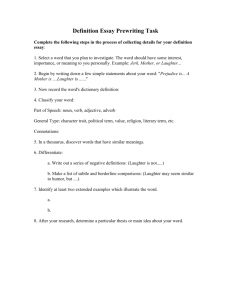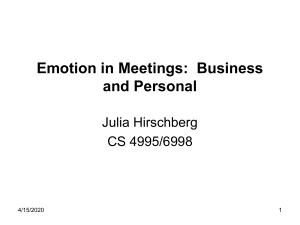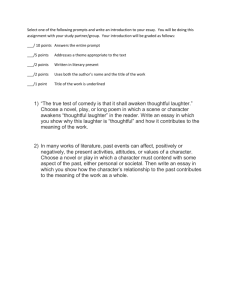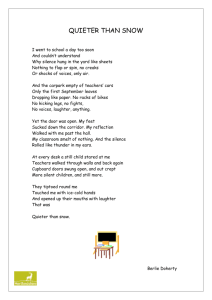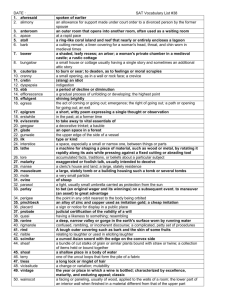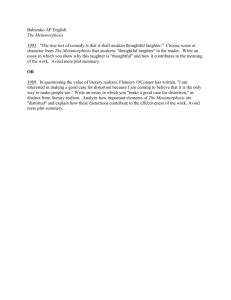Emotion in Meetings: Hot Spots and Laughter
advertisement
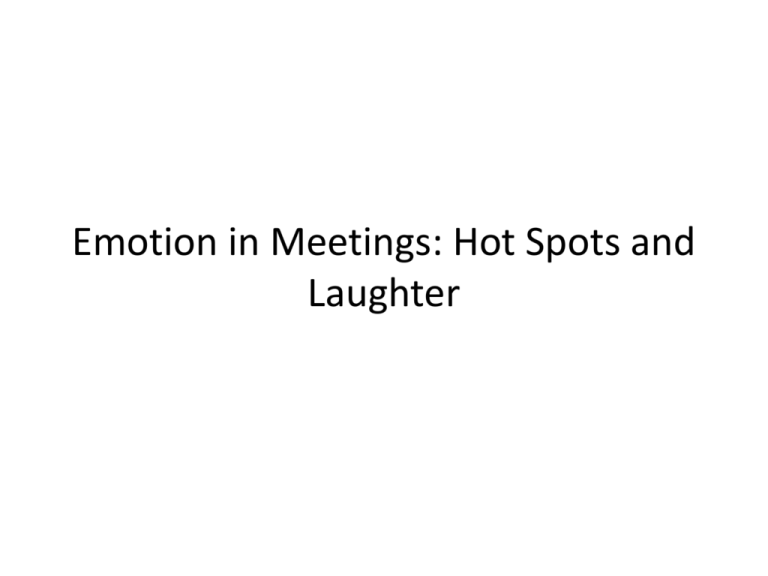
Emotion in Meetings: Hot Spots and Laughter Corpus used • ICSI Meeting Corpus – 75 unscripted, naturally occurring meetings on scientific topics – 71 hours of recording time – Each meeting contains between 3 and 9 participants – Drawn from a pool of 53 unique speakers (13 female, 40 male). – Speakers were recorded by both far field and individual close-talking microphones – The recordings from the close-talking microphones were used Analysis of the occurrence of laughter in meetings - Kornel Laskowski, Susanne Burger Questions asked • What is the quantity of laughter, relative to the quantity of speech? • How does the durational distribution of episodes of laughter differ from that of episodes of speech? • How do meeting participants affect each other in their use of laughter, relative to their use of speech? Question? What could be got out of answering these questions? Method • Analysis Framework – Bouts, calls and spurts – Laughed speech • Data Preprocessing – Talk spurt segmentation • Using the word-level forced alignments in the ICSI Dialog Act (MRDA) Corpus • 300 ms threshold, based on a value adopted by the NIST Rich Transcription Meeting Recognition evaluations – Selection of Annotated Laughter Instances • Vocal sound and comment instances – Laugh bout segmentation • Semi-automatic segmentation Analysis • Quantity of laughter – The average participant vocalizes for 14.8% of the time that they spend in meetings. – Of this effort, 8.6% is spent on laughing and an additional 0.8% is spent on laughing while talking. – Participants differ in both how much time they spend vocalizing, and what proportion of that is laughter. – Importantly, laughing time and speaking time do not appear to be correlated across participants. Question? What is laughed speech? Examples? Analysis • Laughter duration and separation – Duration of laugh bouts and the temporal separation between bouts for a participant? – Duration and separation of “islands” of laughter, produced by merging overlapping bouts from all participants – The bout and bout “island” durations follow a lognormal distribution, while spurt and spurt “island” durations appear to be the sum of two lognormal distributions – Bout durations and bout “island” durations have an apparently identical distribution, suggesting that bouts are committed either in isolation or in synchrony, since bout “island” construction does not lead to longer phenomena. – In contrast, construction of speech “islands” does appear to affect the distribution, as expected. – The distribution of bout and bout “island” separations appears to be the sum of two lognormal distributions. Analysis • Interactive aspects(multi-participant behavior) – The laughter distribution was computed over different degrees of overlap. – Laughter has significantly more overlap than speech; in relative terms, the ratio is 8.1% of meeting speech time versus 39.7% of meeting laughter time. – The amount of time spent in which 4 or more participants are simultaneously vocalizing is 25 times higher when laugher is considered. – Exclusion and inclusion of “laughed speech” Question? Anything odd with the results? Interactive aspects(continued…) • Probabilities of transition between various degrees of overlap: Conclusions • Laughter accounts for approximately 9.5% of all vocalizing time, which varies extensively from participant to participant and appears not to be correlated with speaking time. • Laugh bout durations have a smaller variance than talk spurt durations. • Laughter is responsible for a significant amount of vocal activity overlap in meetings, and transitioning out of laughter overlap is much less likely than out of speech overlap. • The authors have quantified these effects in meetings, for the first time, in terms of probabilistic transition constraints on the evolution of conversations involving arbitrary numbers of participants. Have the questions been answered? Question? Enhancements to this work? Spotting “Hot Spots” in Meetings: Human Judgments and Prosodic Cues - Britta Werde, Elizabeth Shriberg Questions asked • Can human listeners agree on utterance-level judgments of speaker involvement? • Do judgments of involvement correlate with automatically extractable prosodic cues? Question? What could be the potential uses of such a study? Method • A subset of 13 meetings were selected and analyzed with respect to involvement. • Utterances and hotspots • amused, disagreeing, other and not particularly involved. • Acoustics vs context… • Example rating… • The raters were asked to base their judgment as much as possible on the acoustics Question? How many utterances per hotspot, possible correlations? Inter-rater agreement • In order to assess how consistently listeners perceive involvement, inter-rater agreement was measured by Kappa for both pair-wise comparisons of raters and overall agreement. • Kappa computes agreement after taking chance agreement into account. • Nine listeners, all of whom were familiar with the speakers provided ratings for at least 45 utterances but only 8 ratings per utterance were used. Inter-rater agreement • Inter-rater agreement for the high-level distinction between involved and non involved yielded a Kappa of .59 (p < .01) a value considered quite reasonable for subjective categorical tasks. • When Kappa was computed over all four categories, it was reduced to .48 (p < .01) indicating that there is more difficulty in making distinctions among the types of involvement (amused, disagreeing and other) than in making the high-level judgment of the presence of involvement. Question? The authors raise the question whether fine tuning the classes will help improve the kappa coefficient, do you think this would help? Pair-wise agreement Native vs. nonnative raters Question? Would it be a reasonable assumption to assume that non-native rater agreement would be high? Could context have played a hidden part in this disparity? Acoustic cues to involvement • Why prosody? – There is not enough data in the corpus to allow robust language modeling. – Prosody does not require the results of an automatic speech recognizer, which might not be available for certain audio browsing applications or have a poor performance on the meeting data. Acoustic cues to involvement • Certain prosodic features, such as F0, show good correlation with certain emotions • Studies have shown that acoustic features tend to be more dependent on dimensions such as activation and evaluation than on emotions • Pitch related measures, energy and duration can be useful indicators of emotion. Acoustic features • F0 and energy based features were computed • For each word either the average, minimum or maximum was considered. • In order to obtain a single value for the utterance, the average over all the words was computed • Either absolute or normalized values were used. Correlations with perceived involvement • The class assigned to each utterance was determined as a weighted version of the ratings. (A soft decision, accounting for the different ratings in an adequate way) • The difference between the two classes are significant for many features. • The most affected features are all F0 based • Normalized features lead to greater distinction than absolute features • Patterns remain similar, and the most distinguishing features are roughly the same when within speaker features are analyzed • Normalization removes a significant part of the variability across speakers Question? How could the weighted ratings have been used in the comparison of features? Conclusions • Despite the subjective nature of the task, raters show significant agreement in distinguishing involved from non-involved utterances. • Differences in performance between native and nonnative raters indicate that judgments on involvement are also influenced by the native language of the listener. • The prosodic features of the rated utterances indicate that involvement can be characterized by deviations in F0 and energy. • It is likely that this is a general effect over all speakers as it was shown for a least one speaker that the most affected features of an individual speaker were similar to the most affected features that were computed over all speakers. • If this holds true for all speakers this is an indication that the applied mean and variance as well as baseline normalizations are able to remove most of the variability between speakers. Have the questions been answered?
